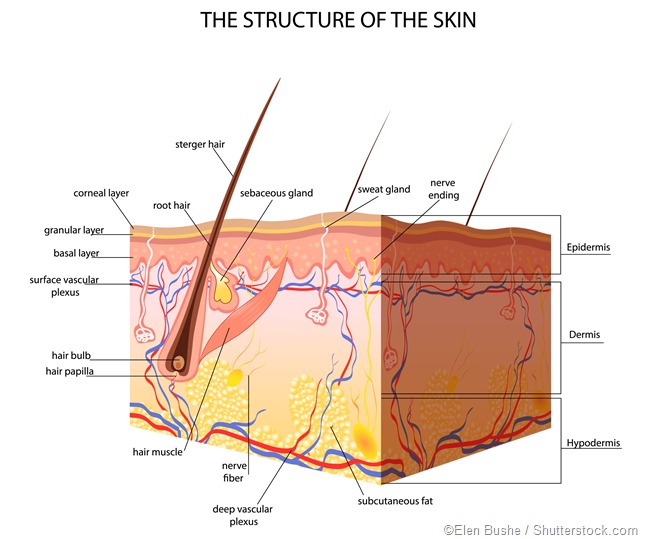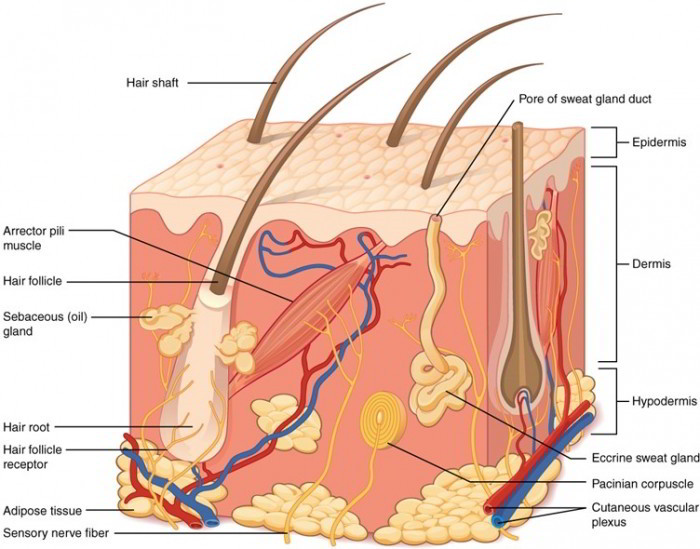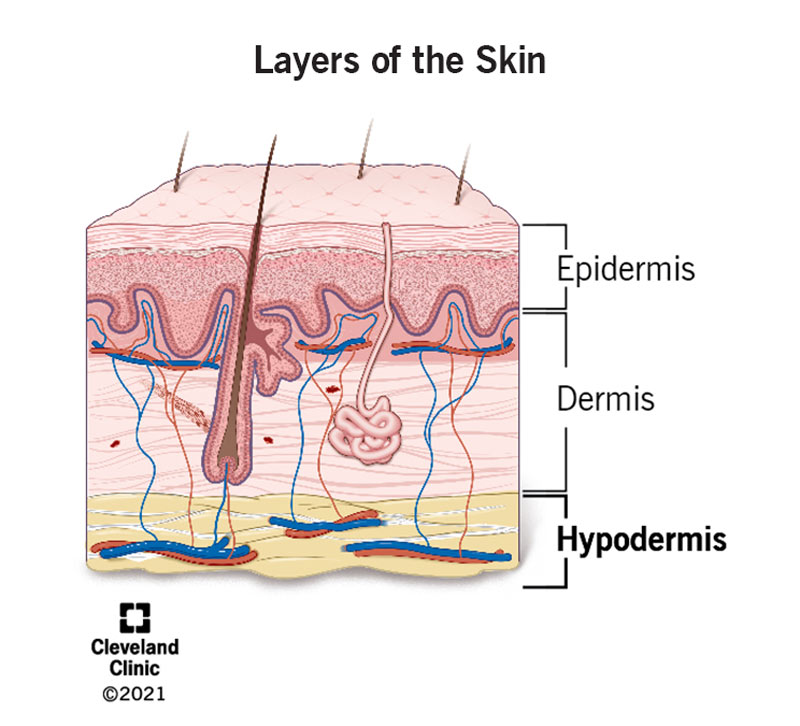Describe the Subcutaneous Layer and Its Functions
The epidermis consists of several layers The topmost layer consists of dead cells that shed periodically and is progressively replaced by cells formed from the basal layer. The dermis supports the epidermis providing nutrients and protecting it.
It has many functions including insulating your body protecting your body from harm storing energy and connecting your skin to your muscles and bones.

. Subcutaneous tissue is composed of an insulating layer of fat and blood vessels source. The skins structure is made up of an intricate network which serves as the bodys initial barrier against pathogens UV light and chemicals and. Also called adipose or subcutis tissue.
The amount proportion and arrangement of each. 78 Of note the retinacular cutis is the name given to that portion of the retaining ligament that passes through the subcutaneous tissues. Name specific structural components of the basement membrane zone dermis and subcutis.
The blood vessels in the hypodermis are bigger and connect to the rest of your body. Subcutaneous adipose tissue absorbs the forces created by impact to the. Describe the layers of the skin and the functions of each layer.
It provides the main structural support for the skin as well as insulating the body from cold and aiding shock absorption. Skin is the largest organ in the body and covers the bodys entire external surface. It consists largely of fat.
The hypodermis is made of subcutaneous under the skin fats connective tissues blood vessels and nerve cells. List the functions of the subcutaneous layer. The deepest layer of the skin is called the subcutaneous layer the subcutis or the hypodermis.
The subcutaneous layer of skin houses the arterioles that regulate temperature and also acts as a layer for fat storage a shock absorber and as insulation. Importantly the subcutis contains a layer of fat. The subcutaneous layer pads and protects the body acts as energy reservoir and provides thermal insulation.
The hypodermis also called the subcutaneous layer or superficial fascia is a layer directly below the dermis and serves to connect the skin to the underlying fascia fibrous tissue surrounding the muscles. It is the site used for subcutaneous injections and where white blood cells attack pathogens that have penetrated the skin. Define the skin as an organ and a component of the integumentary system.
A superficial epidermis and a deeper dermis. Describe the general functions of the subcutaneous layer also known as the hypodermis or superficial fascia. Subcutaneous tissue Fatty layer found below the dermis that gives smoothness and contour to the body contains fat for use as energy and also acts as a protective cushion for the outer skin.
Though many people arent particularly grateful for the fat in their bodies the fat in the subcutaneous layer would likely be missed if it were to disappear considering that it protects the organs and bones and keeps the bodys temperature where it ought to be. The basement membrane zone is the communication channel between epidermis and dermis. List the structural layers of the epidermis and describe their functions.
This layer is important is the regulation of. Its the layer of skin where fat is deposited and stored. The hypodermis is the subcutaneous layer lying below the dermis.
It is the deepest skin layer composed of. The subcutaneous layer is located underneath the dermis and is one of the three layers of the skin. List the functions of the integumentary system.
The subcutaneous tissues serve four functions regulating body temperature is key The subcutaneous layer also serves to protect the inner organs and bones and plays an important role in. Explain how the skin is structurally divided into epidermal dermal and subcutaneous regions. The subcutaneous layer has two components.
Like the dermis the layer contains blood vessels and nerves for much the same reasons. The subcutaneous hypodermis layer is a specialized layer of connective tissue containing adipocytes. It is not strictly a part of the skin although the border between the hypodermis and dermis can be difficult to distinguish.
Hypodermis Subcutaneous Tissue Your hypodermis is the bottom layer of skin in your body. The skin is composed of two major layers. This layer is filled with adipose tissue which is body fat as well as loose connective tissue containing collagen and blood vessels which of course connect to the inside of our bodies.
The subcutaneous tissue is a layer of fat and connective tissue that houses larger blood vessels and nerves. It is made up of three layers the epidermis dermis and the hypodermis all three of which vary significantly in their anatomy and function. The hypodermis also known as the subcutaneous layer or tissue is the deepest and thickest of the three layers of skin and located right above muscle.
Structure of the dermis and subcutis. Stores fat cells for energy reserves Gives the body its smooth contoured appearance Regulates temperature through the contraction and dilation of blood vessels Serves as the attachment point for bones muscles and other organs to the skin Contains deep pressure sensors. This layer of fat works alongside the blood vessels to maintain an appropriate body temperature.
The subcutaneous layer also. The subcutaneous fat which provides volume and the fibrous retinacular cutis that binds the dermis to the underlying SMAS of the face. It consists primarily of areolar connective tissue and adipose tissue.
Skin General Functions Structure Anatomy Epidermis Layers Cells

Function And Structure Of Skin And Subcutaneous Tissue Earth S Lab

No comments for "Describe the Subcutaneous Layer and Its Functions"
Post a Comment